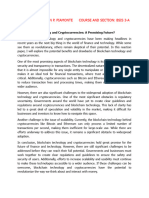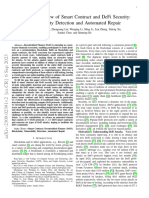Introduction to Blockchain Blockchain is a decentralized digital ledger technology that enables
secure, transparent, and immutable record-keeping of transactions. It was initially developed as the
underlying technology behind Bitcoin, the first cryptocurrency, but its potential extends far beyond
cryptocurrencies. Blockchain has the ability to revolutionize industries by providing secure ways to
store and share data, eliminate intermediaries, and enhance transparency in various sectors. At its
core, blockchain is a chain of blocks, each containing data and connected to one another using
cryptography. Unlike traditional centralized systems, blockchain operates on a decentralized network,
where each participant (or node) has access to the same copy of the ledger, ensuring transparency
and trust. Key Components of Blockchain To understand how blockchain works, it’s important to look
at its key components: 1. Blocks Each block contains: • Data: Information about transactions (e.g.,
sender, receiver, timestamp). • Hash: A unique identifier generated by a cryptographic function that
represents the block’s data. • Previous Block Hash: The hash of the previous block in the chain,
ensuring that the blocks are linked together. 2. Decentralized Network In a blockchain, there is no
central authority controlling the network. Instead, participants (nodes) are distributed across the
network. This decentralization ensures that no single entity has control over the entire system and
prevents any single point of failure. 3. Consensus Mechanism Blockchain networks use consensus
mechanisms to validate and agree on the state of the blockchain. Popular consensus algorithms
include: • Proof of Work (PoW): Used by Bitcoin, where participants (miners) solve complex
mathematical puzzles to validate transactions and add blocks. • Proof of Stake (PoS): Participants
validate transactions and create new blocks based on the amount of cryptocurrency they hold and
are willing to "stake" as collateral. • Delegated Proof of Stake (DPoS): A variation of PoS where
participants vote on a set of validators to process transactions. 4. Smart Contracts Smart contracts
are self-executing contracts with the terms of the agreement directly written into code. They
automatically execute actions when predefined conditions are met, reducing the need for
intermediaries. These contracts are commonly used in decentralized applications (dApps). How
Blockchain Works Blockchain works by adding a new block of data to the chain every time a
transaction occurs. Here’s a simplified overview of the process: 1. Initiating a Transaction: A user
requests a transaction (e.g., sending cryptocurrency). 2. Verification: The transaction is broadcast to
the network, where multiple nodes validate it using a consensus mechanism. 3. Block Creation: Once
validated, the transaction is added to a new block along with other transactions. 4. Adding to the
Blockchain: The new block is linked to the previous block using its hash, creating a chain of blocks.
This ensures that no one can alter past transactions. 5. Transaction Confirmation: Once the block is
added, the transaction is confirmed and becomes part of the permanent, immutable record. This
process guarantees the integrity, security, and transparency of the blockchain without the need for
centralized authority. Key Features of Blockchain 1. Decentralization Unlike traditional centralized
systems where data is stored and managed by a single entity, blockchain is decentralized. This
ensures that no single party can manipulate or control the data, providing a higher level of trust and
security. 2. Transparency All participants in a blockchain network have access to the same data,
which enhances transparency. Transactions are visible to all participants, making it difficult for any
party to manipulate the data without others noticing. 3. Immutability Once data is added to a
blockchain, it cannot be altered or deleted. This immutability ensures the integrity of the data and
protects it from tampering or fraud. 4. Security Blockchain uses cryptographic techniques to secure
data, making it resistant to hacking and fraud. The decentralized nature of the network further
enhances security by making it more difficult for malicious actors to attack the system. Applications
of Blockchain Blockchain is finding applications across various industries due to its ability to provide
secure, transparent, and efficient solutions. Here are some key applications: 1. Cryptocurrencies
Blockchain is most commonly associated with cryptocurrencies like Bitcoin and Ethereum. These
digital currencies rely on blockchain to record transactions and ensure security without the need for
�a central authority like a bank. 2. Supply Chain Management Blockchain can be used to track
products as they move through the supply chain, ensuring transparency and reducing fraud. By
recording every step in the process on the blockchain, stakeholders can verify the authenticity and
origin of goods, improving efficiency and trust. Example: Companies like Walmart and IBM are using
blockchain to improve food traceability in the supply chain, ensuring that products meet safety
standards and are ethically sourced.






















































































